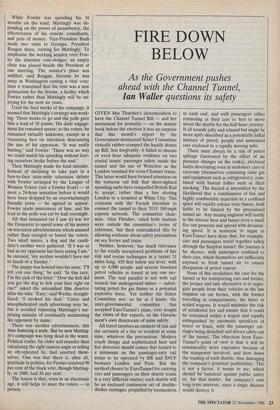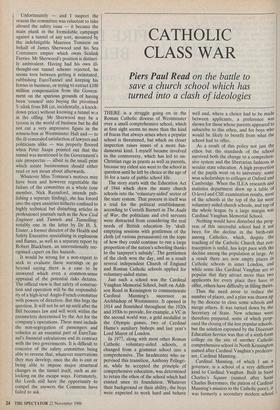FIRE DOWN BELOW
As the Government pushes ahead with the Channel Tunnel,
Ian Waller questions its safety GIVEN Mrs Thatcher's determination to have the Channel Tunnel Bill — and her monument for posterity — on the statute book before the election it was no surprise that this month's report by the Government-dominated Select Committee virtually rubber-stamped the hastily drawn up Bill; less forgivably, it failed to discuss or even hear adequate evidence on two crucial issues: passenger safety inside the tunnel and the use of Waterloo as the London terminal for cross-Channel trains. This latter would have focused attention on the tortuous rail link that short-sighted spending curbs have compelled British Rail to accept, rather than a line skirting London to a terminal at White City. This contrasts with the French intention to connect the tunnel to their TGV 160-mph express network. The committee chair- man, Alex Fletcher, ruled both matters were outside the committee's terms of reference, but then contradicted this by allowing evidence about safety precautions on sea ferries and trains.
Neither, however, has much relevance to the totally unexplored problems of fire risk and rescue techniques in a tunnel 31 miles long, 450 feet below sea level, with up to 4,000 people and several hundred petrol vehicles in transit at any one mo- ment. The real parallel is not with rail tunnels but underground mines — substi- tuting petrol for gas fumes as a potential explosive force. Yet neither the Select Committee nor, so far as I know, the inter-governmental committee that accepted EuroTunnel's plans, ever sought the views of fire experts, or the Govern- ment's own directorate of mine safety.
All travel involves an element of risk and the certainty of a fire or accident at some time, whatever the precautions. Modern coach design and sophisticated heat and fire detectors should reduce that hazard to a minimum on the passenger-only rail trains to be operated by BR and SNCF between London and Paris. But the method chosen by EuroTunnel for carrying cars and passengers on their shuttle trains is a very different matter; each shuttle will be an enclosed continuous set of double- decker carriages, propelled by locomotives at each end, and with passengers either remaining in their cars or free to move about the shuttle for the half-hour journey. It all sounds jolly and relaxed but might be more aptly described as a potentially lethal mixture of petrol, people and unsecured cars enclosed in a rapidly moving tube.
There must always be a risk of petrol spillage (increased by the effect of air pressure changes on the tanks), electrical faults developing even in stationary cars or caravans (themselves containing calor gas and equipment such as refrigerators), com- bined with human follies such as illicit smoking. The hazard is intensified by the likelihood that a combination of fire and highly combustible materials in a confined space will rapidly release toxic fumes, both liable to be fanned by the pressurised tunnel air. Any mining engineer will testify to the intense heat and fumes even a small fire can generate and spread with devastat- ing speed. It is nonsense to argue as EuroTunnel have done that, for example, cars and passengers travel together safely through the Simplon tunnel; the journey is far shorter, with passengers confined to their cars, which themselves are sufficently exposed to fresh tunnel air to ensure dissipation of petrol vapour.
None of this invalidates the case for the tunnel or for transporting cars and lorries; the proper and safe alternative is to segre- gate people from their vehicles as the law requires on car ferries, with the former travelling in compartments, the latter in sealed wagons. It would minimise the risk of accidental fire and ensure that it could be contained within a wagon and rapidly extinguished by automatic sprinklers of water or foam, with the passenger car- riages being detached and driven safely out of the tunnel. The objection from Euro- Tunnel's point of view is that it will be considerably more expensive because of the manpower involved, and slow down the loading of each shuttle, thus damaging the company's potential profitability. This is not a factor, it seems to me, which should be balanced against public safety or, for that matter, the company's own long-term interests, since a single disaster would destroy it. Unfortunately — and I suspect the reason the committee was reluctant to take aboard the safety issue — it became the main plank in the formidable campaign against a tunnel of any sort, mounted by the indefatigable Maureen Tomison on behalf of James Sherwood and his Sea Containers empire which owns Sealink Ferries. Mr Sherwood's position is distinct- ly ambivalent. Having had his own ill- thought-out tunnel scheme rejected, he seems torn between getting it reinstated, rubbishing EuroTunnel and keeping his ferries in business, or trying to extract f100 million compensation from the Govern- ment on the spurious grounds of having been `conned' into buying the privatised S alink from BR (at, incidentally, a knock- down price) without knowing a tunnel s in the offing. Mr Sherwood may be a tycoon in the world of business but he did not cut a very impressive figure in the witness-box at Westminster Hall and — to the ill-concealed satisfaction of lawyers and politicians alike — was properly floored when Peter Snape pointed out that the tunnel was mentioned in the Government's sale prospectus — albeit in the small print which astute businessmen should either read or not moan about afterwards.
Whatever Miss Tomison's motives may have been and however regrettable the failure of the committee as a whole (one member, Nick Raynsford, intends pub- lishing a separate finding), she has forced into the open anxieties hitherto confined to highly technical but disturbing articles in professional journals such as the New Civil Engineer and Tunnels and Tunnelling; notably one in the latter by Dr H. S. Eisner, a former director of the Health and Safety Executive specialising in explosions and flames, as well as a separate report by Robert Blackburn, an internationally rec- ognised expert on fire hazards.
It would be wrong for a non-expert to seek to evaluate these warnings or go beyond saying there is a case to be answered which even a common-sense appraisal of the potential risks dictates. The official view is that safety of construc- tion and operation will be the responsibil- ity of a high-level Anglo-French committee with powers of direction. But this begs the question. It will not be set up until after the Bill becomes law and will work within the parameters determined by the Act for the company's operations. These must include the non-segregation of passengers and vehicles as an essential part of EuroTun- nel's financial calculations and its contract with the two governments. It is difficult to conceive of the safety committee being able to reverse that, whatever reservations they may develop, once the die is cast or being able to impose major structural changes in the tunnel itself, such as air- locking on the escape ways. Fortunately, the Lords still have the opportunity to compel the answers the Commons have failed to ask.



























































 Previous page
Previous page